Competing on multiple fronts is typically a death-blow for small to mid-sized clubs. After qualifying for continental play, many of these clubs are forced to sell the top talent that produced the additional competition. Lacking the resources to acquire suitable squad depth and a run of injuries leads many of these clubs to the bottom of the league table.
Though many expected Getafe to succumb to the burden of domestic and European competition, this side has shown the mettle of a UEFA Champions League team. As we stroll into the middle of February, José “Pepe” Bordalás has his Getafe side preparing for the Europa League Round of 32 against Ajax while laying claim to third place in La Liga. A massive showdown against Barcelona at the Camp Nou awaits, but the small-pocketed Madrid side shows no signs of fading.
In this tactical analysis, we’ll dive into this hard-nosed Getafe side, providing a scout report as to how Bordalás’ side has overcome its limited resources to position itself for a first-ever Champions League qualification. Recent dominant performances against Valencia and Athletic Bilbao served notice to the league…this Getafe side has no plans of fading. When you play Getafe, come prepared for a fight.
Typical starting lineup
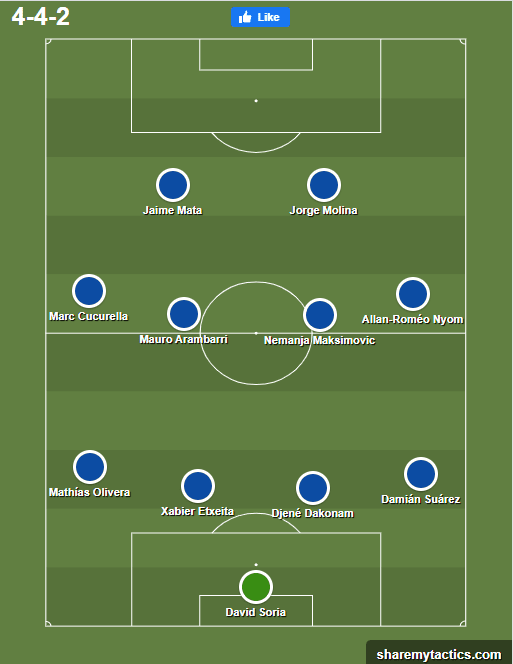
Bordalás is a 1-4-4-2 guy. His side has played that formation in every game this season. Though he has a few options to rotate the squad, which will be especially important when Getafe resume Europa League play, Bordalás has picked a rather consistent starting XI over the past four matches. David Soria is the man in goal, with Damián Suárez and Djené Dakonam featuring on the backline throughout the season. In recent weeks, Xabier Etxeita and Mathías Olivera have become regulars. Barcelona loanee Marc Cucurella routinely plays left-midfield with Mauro Arambarri and Nemanja Maksimovic in the middle of the pitch and Allan-Roméo Nyom seeing more time at right-midfield. Up top, 37-year-old Jorge Molina and 31-year-old Jaime Mata provide the goals, as does super-sub forward Ángel Rodríguez. Though Leandro Cabrera and Jason are not listed, they have started 18 and 11 games respectively, making them key pieces of the team’s rotation.
With this new lineup, Getafe has four wins in four games when playing a league opponent for the second time. In the first game against Valencia, Athletic Bilbao, Real Betis, and Leganes, Getafe could only muster one win, two draws and a loss, good for just five points compared to the 12 points out of 12 in the return leg. In those four return legs, Getafe has recorded an 8.41 xG which produced nine goals. Meanwhile, Getafe has four clean sheets while holding opponents to a paltry 2.41 xG. That tally includes the demolition job at home against Valencia, holding the Champions League Round of 16 contestants to a staggeringly low .07 xG, including zero shots on goal. Bordalás seems to have found his ideal lineup and recent results have his side well-positioned to achieve club history.
Counterpressing from compact starting points
For this Getafe team, the defensive approach is the starting point. While the team rates average to below average in many of the statistics that reference individual defending ability, such as a 57.8% success rate in defensive duels vs the 58.14% league average, it’s the collect approach that leads to the Azulones’ success.
A 7.09 PPDA (passes per defensive action) leads the league in pressing intensity. Using its narrow starting points as a defensive weapon, Getafe transitions from attack to defense better than any team in La Liga. If the initial wave of pressure is broken, Getafe will do whatever it takes to prevent the opponent from running at the backline.
It leads the league in fouls (426) and yellow cards (76), while also rating second in challenge intensity and aerial duels. Progressing into the Getafe half is difficult, but getting a shot off is the ultimate challenge against this tenacious side. With only 159 shots against, Getafe easily leads the league in the category, distancing themselves from second-place Real Madrid (173) and Sevilla (207).
Right from the start, Getafe imposes itself on the opponent with a very narrow shape, both in defense and the attack. Typically, you’ll see Getafe defend and attack from three consecutive vertical channels. Once the ball is lost, it engages the opponent in an aggressive counterpress. This is the reason that, despite one of the lowest possession percentages in the league, Getafe doesn’t spend much of the game defending in the low block. Instead, you’ll see the counterpress high up the pitch, forcing the opponent to play backward or laterally just to break the first couple of tackles. In that time, Getafe’s midfield is tightening up, eliminating passing lanes while positioning themselves ball-side of the nearest opponent.
With the game in a highly transitional state, Getafe’s narrow approach allows for quick transitions to defence, as well as keeping the opponent off-balance. In the game against Real Madrid, Los Blancos greatly struggled to penetrate Getafe’s lines in the first half. Positional attacks were unsuccessful due to the defence’s numbers around the ball and more vertical attacks were difficult because of conservative play of the backline. Getafe’s outside-backs rarely join in the attack, staying deep to prioritize defensive solidity. When they do get forward, it’s typically a late run to send a cross from a deeper part of the pitch. At Getafe, defensive coverage is the priority and all tactics rest on a defensive foundation.
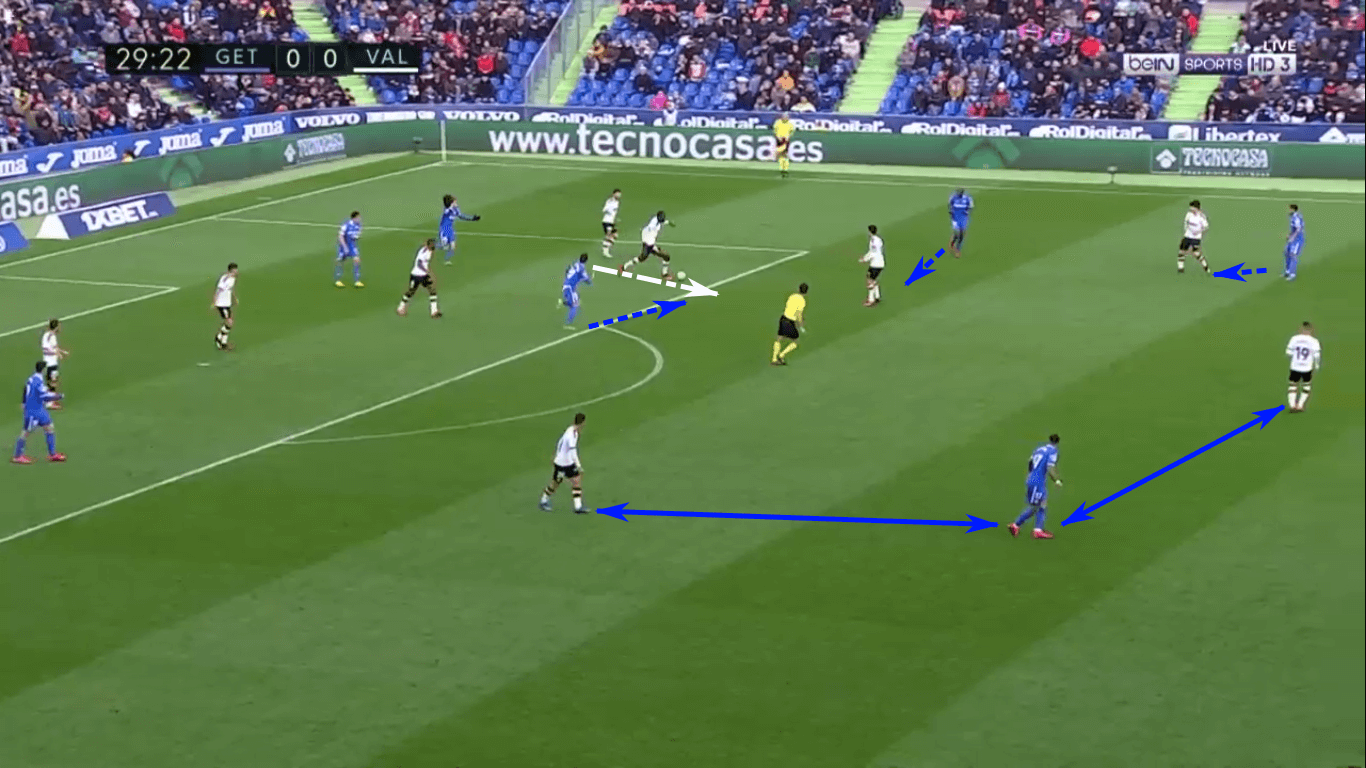
Immediately after winning a tackle, Geoffrey Kondogbia took a couple of touches away from pressure to set up his pass. As he took his touches, Getafe immediately swarmed to him. Given the compactness of its attacking shape, the home side was well-positioned to counterpress.
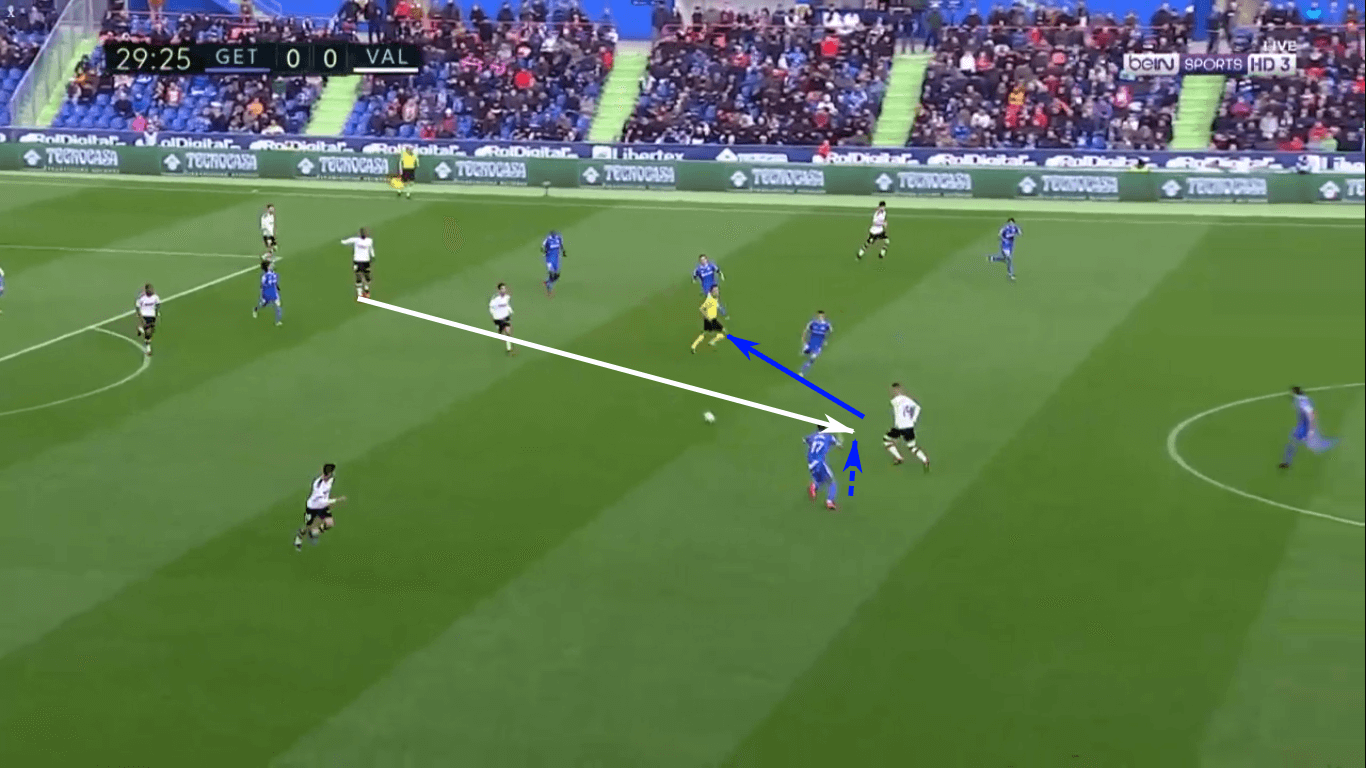
With time and space working against him, Kondogbia played a 20-metre pass up the field. Olivera anticipated the pass beautifully and intercepted it, initiating another Getafe attack that ended in a shot. Valencia found it difficult to play out of the counterpress. Plus, the two Rodrigo Moreno and Maxi Gomez, were swarmed by Getafe defenders and had little luck holding up the ball long enough for their teammates to join in the attack. Though Valencia was undoubtedly poor in this match, Getafe was brilliant, especially when defending in the attacking half of the pitch.
Vertical, quick-strike attacking
As mentioned in the last section, Getafe’s outside-backs are infrequent attackers in this tactical system. The analysis shows that defensive solidity is the priority, but the lack of use is also a byproduct of a vertical, quick-strike attack. A data-driven approach to goal scoring shows that this is the most efficient means of scoring. During the 2018/19 UEFA Champions League-winning season, 51% of goal-scoring moves originated in the attacking third. 30% of goals started with the defensive team recovering a loose ball or opponent’s poor pass. Jürgen Klopp’s Liverpool averaged 7.81 seconds of possession and an average of 2.51 passes per goal. Even the league averages of 12.50 seconds and 3.89 passes per goal-scoring action shed light on the idea Bordalás has brought to Getafe. Rather than asking a group of blue-collar players to build out of the back, connect 17 passes so the team can get its attacking shape, switch play 15 times and produce a shot through a central combination, the Spaniard wants his side to play a direct, cutthroat style. It might not be the most aesthetically pleasing brand, but what Getafe has managed with limited resources is remarkable.
Getafe sends a lot of long passes (1275), rating second in La Liga in the stat. Looking at some of the other key attacking statistics, you see that this is not a team built to win a high-scoring affair. Getafe is 16th in shots per game (9.24), 18th in possession (43.6%), ninth in key passes (2.77), 14th in touches in the box (12.79) and 10th in xG (28.46 for the season). To its credit, Getafe is fourth in passes to the final third, averaging a respectable 60.2% success rate.
A couple of the reasons this attack has managed to over-perform its xG by seven goals are clinical finishing and committing numbers high up the pitch. Amidst the chaos of inducing long passes are opportunistic Getafe attackers looking to pounce on a loose ball or defensive miscue. When Getafe is experiencing a lot of attacking joy, the forwards are getting into the box with two or three midfielders joining them. This side crashes the goal really well, regularly attacking services in equal number situations. While the Madrid-based club sends a relatively high number of crosses per game (15.8 is sixth in La Liga), it’s most effective dribbling at the backline and playing to the feet of the big, goal-facing forwards. Jaime Mata and Jorge Molina have combined for a 13 goal haul in La Liga with Ángel Rodríguez, the diminutive super-sub, pacing the team with nine.
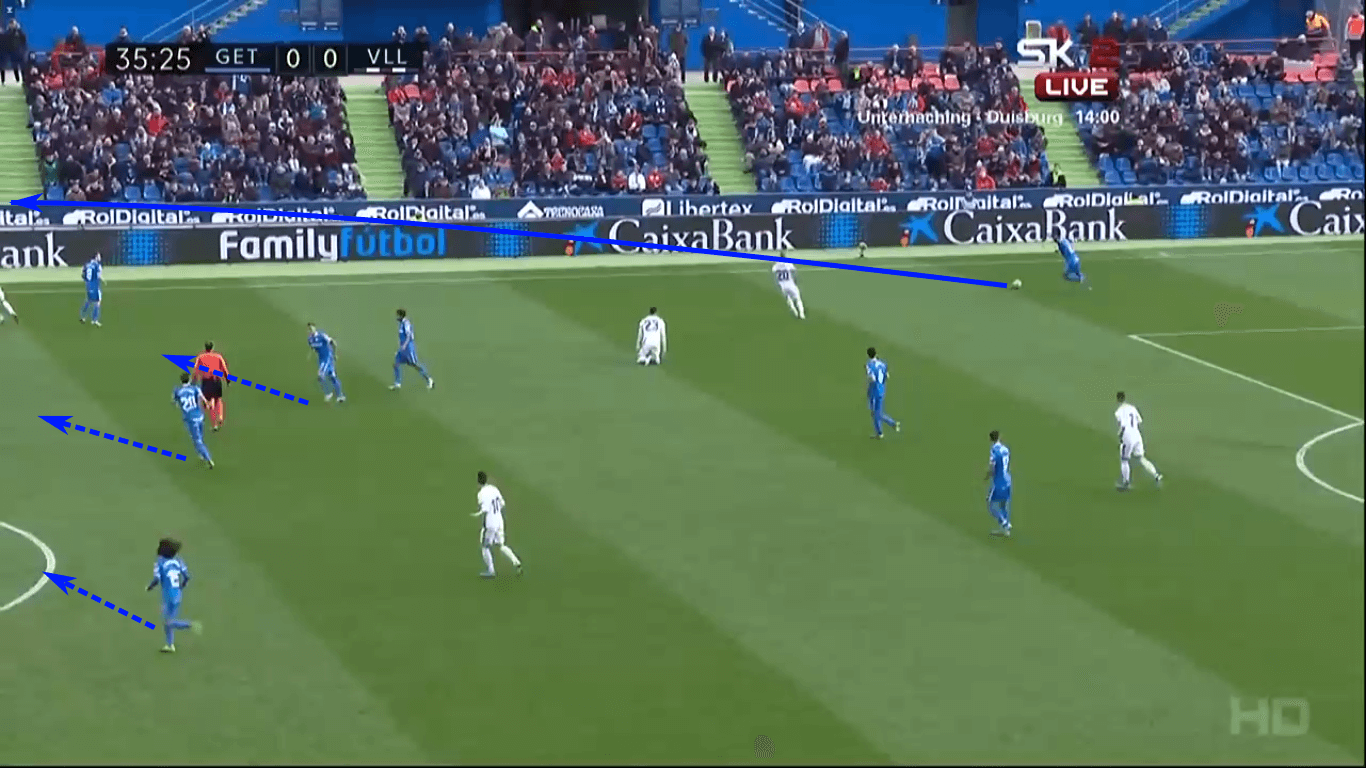
In the 36th minute against Real Valladolid, Getafe prepared to initiate an attack down old Route 1.
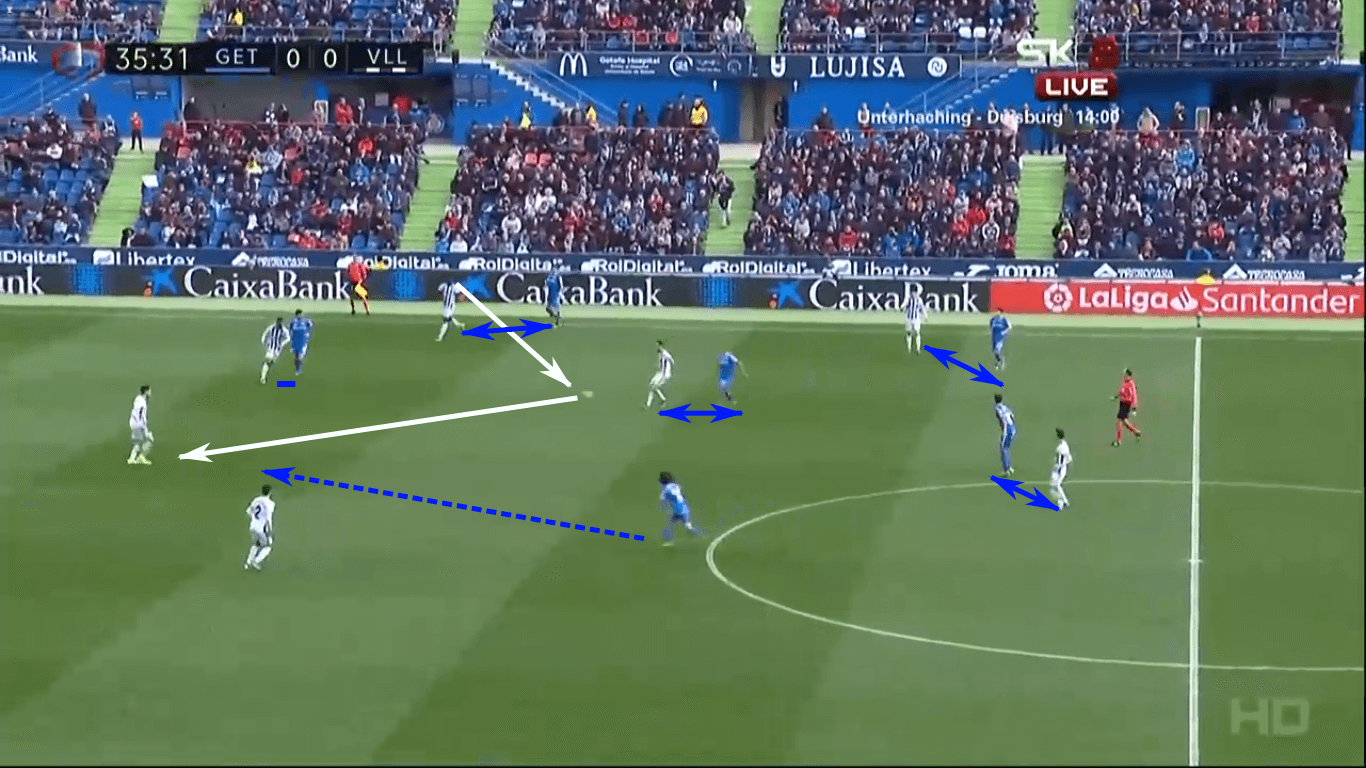
After a contested header, Valladolid managed to claim the second ball, but could only go backward. Notice the anticipation of Cucurella. He’s on the move and set to pressure.
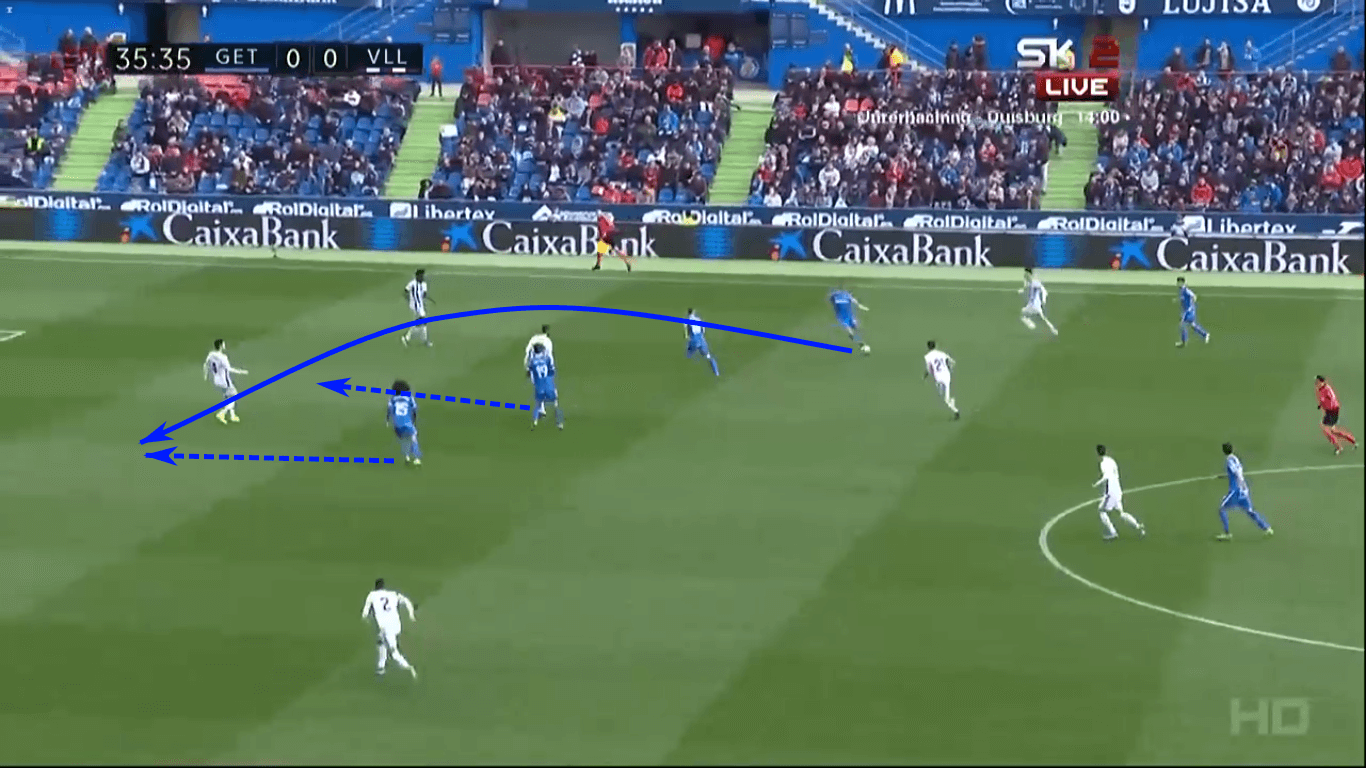
Cucurella’s pressure produced an errant pass, which Mata claimed and promptly sent forward to Cucurella. This is one of Getafe’s attacking principles in action. Upon winning the ball, ball a positive first pass, preferably breaking a line. If you’re off the ball, get high quickly.
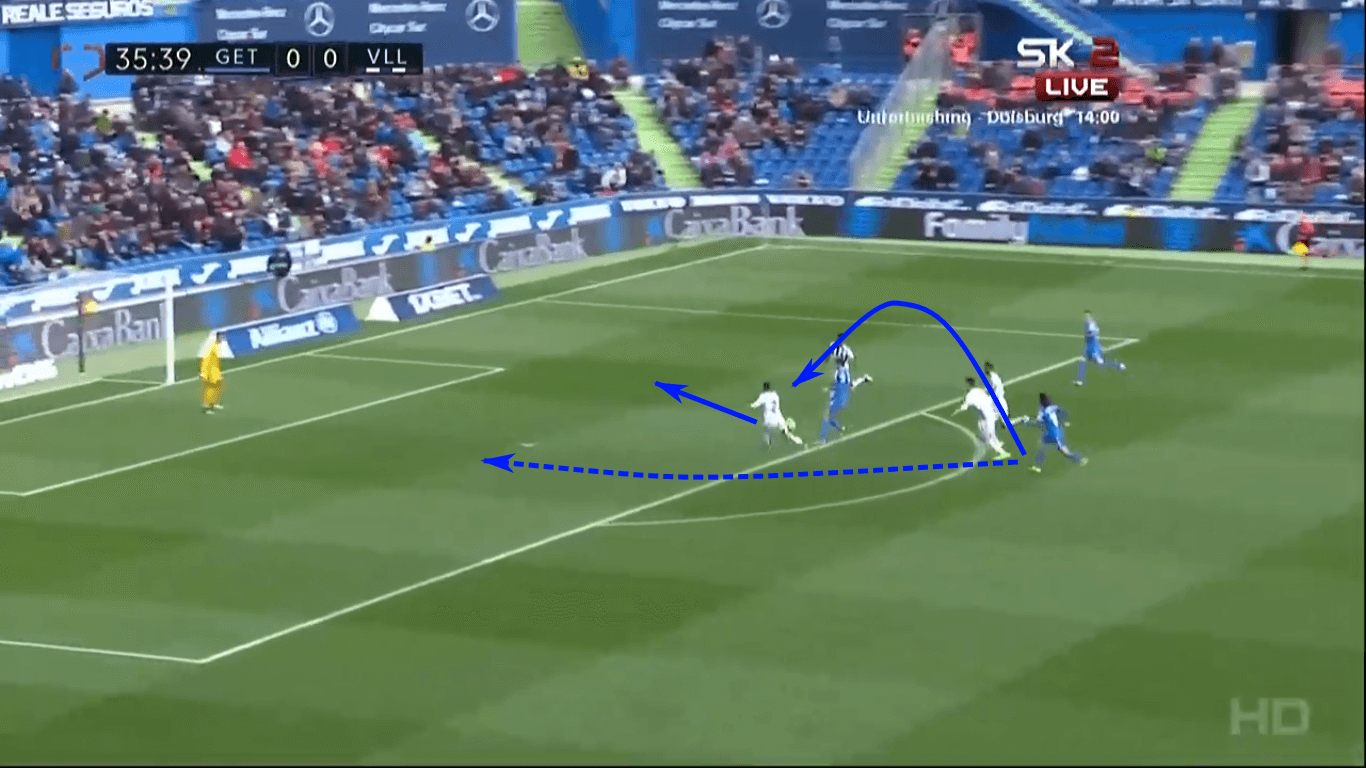
Cucurella flicked the ball over the defence onto the run of Molina.
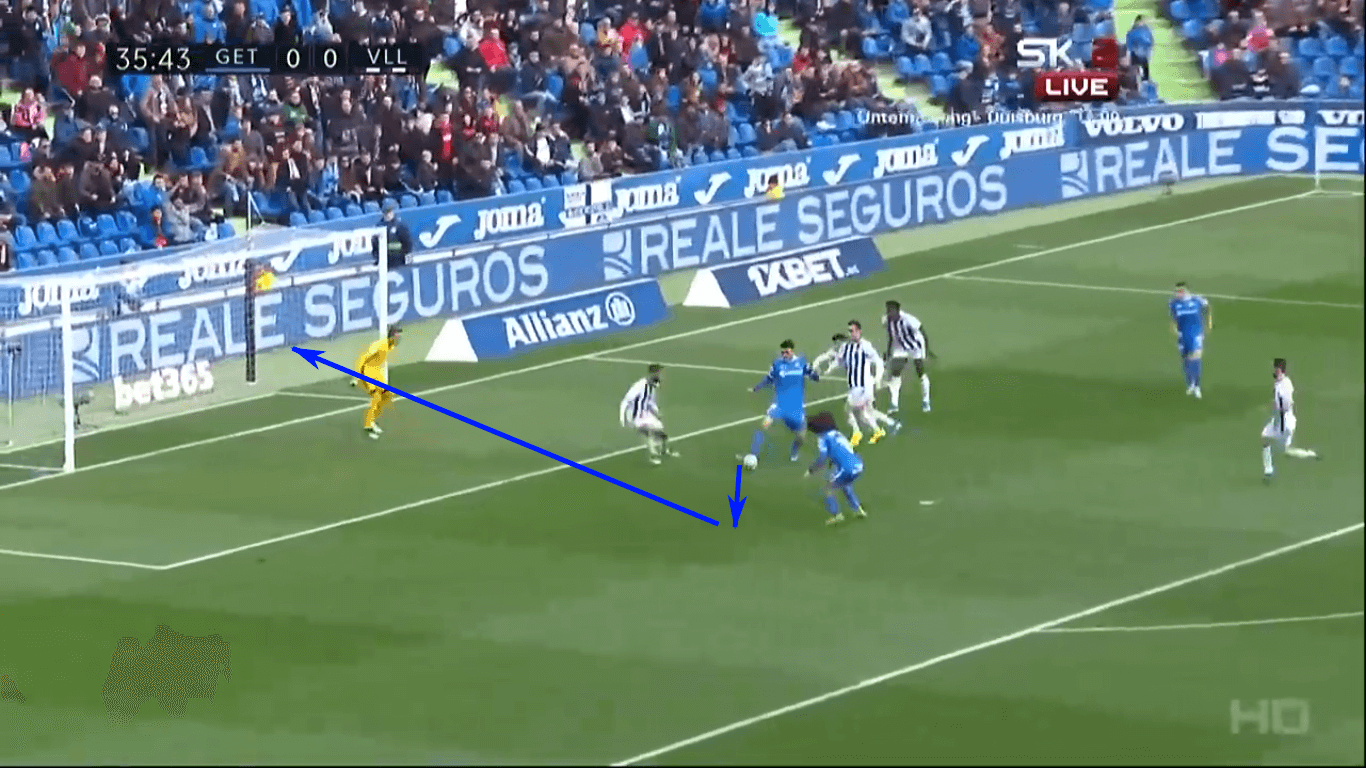
The captain shielded the ball from four opponents before setting the ball back to Cucurella, who blasted home the game-winning goal.
Set piece dominance
Only one team has scored more goals from set-pieces and penalty kicks in La Liga, and that side has Lionel Messi delivering those dead balls. With eight set-piece goals and another five from the penalty spot, Getafe is among the top teams in La Liga in scoring from outside of open play. Ranking fifth in corners taken per game with a mark of 4.81, Getafe also allows an incredibly low number of corners per game (3.3). The side uses its size well, frequently out-muscling and maneuvering opponents in man-marking situations. That said, there’s no situation that best represents this side’s tenacity than a set-piece. Each player battles for positioning knowing that they simply won’t get many chances in a given game.
When Getafe takes a corner kick, expect it taken short. Movements typically start once the short pass is played, allowing players to move more freely as the defensive team keeps an eye on the ball. Just before the delivery, it’s common to see Getafe move to overload an area of the box. One thing that popped out was that few players occupy the middle of the goal. The overload typically takes place at one of the two posts. If at the far post, the intent is generally to go to goal. If at the near post, a flick or dummy is common.
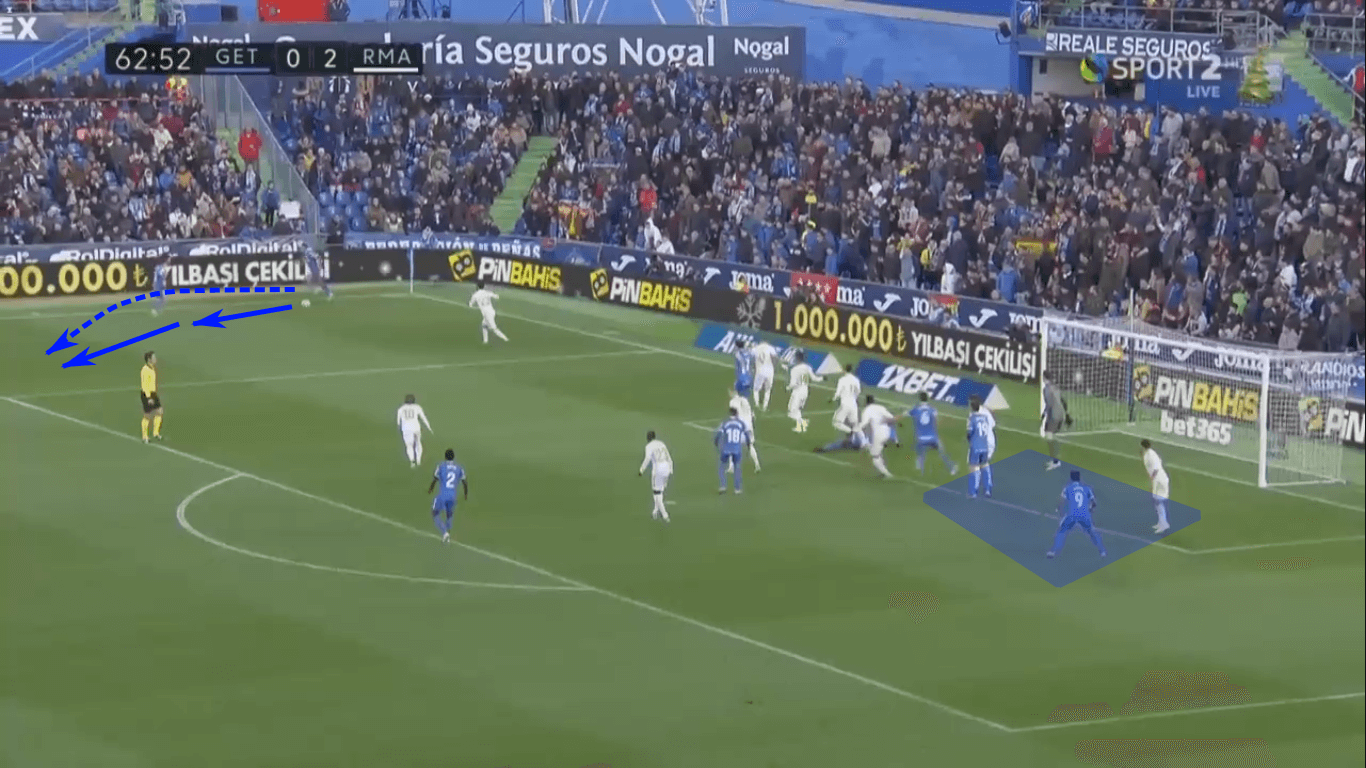
Getafe takes a short corner, triggering Real Madrid to push its backline higher up the pitch. As Madrid move higher, Getafe seized the opportunity to shuffle its numbers, overloading the far post.
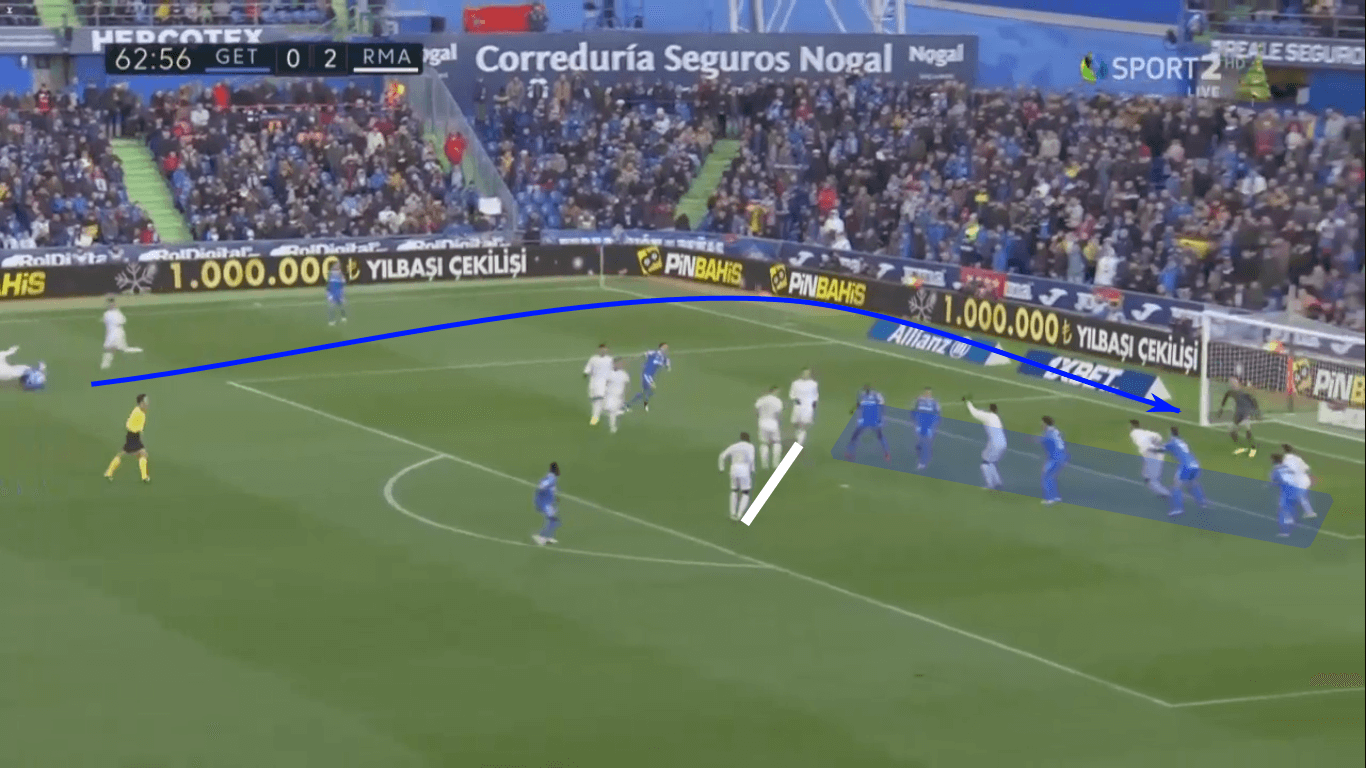
With the Madrid lines disconnected and the far post dominated by blue shirts, Suárez delivered the cross to the far post. Cabrera was there to meet it, but his header was poor. Still, behind that line of three Madrid defenders is a 5v3 that favours Getafe. Creating a numerical overload is one of the central set piece tactics employed by Getafe and one of the reasons it’s among the best set-piece sides in La Liga.
Conclusion
Despite being a striker during his playing days, Bordalás has built a team that excels when defending in the opposition’s half of the field. An aggressive counterpress is at the heart of this side’s success, allowing Getafe to relaunch attacks on a short field with numbers high up the pitch. The attack can certainly have a scrappy look to it, but the chaos those attacks produce greatly benefits the mentally strong approach of Getafe.
Though some, myself included, thought this would be a down year for Getafe as it had to cope with the additional strain of competing in the Europa League, Bordalás and his men are closing in on the best finish in the club’s history. Securing UEFA Champions League play at the expense of a larger Spanish side would be a remarkable feat. This is all the making of a Coach of the Year campaign for Bordalás. With two routes to the Champions League still in play, Getafe is on the verge of history and looked primed to take the step. These last two La Liga games in February, away to Barcelona and home to Sevilla, are opportunities to show that Getafe has the collective strength to stay among the leaders and secure a coveted Champions League spot.





Comments